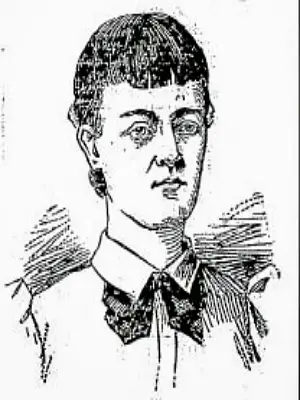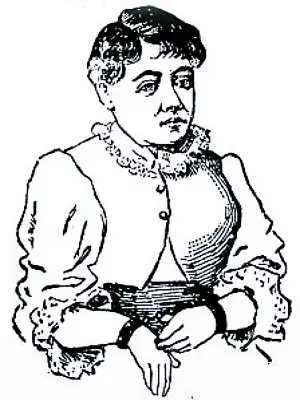In August 1893, a shocking discovery was made on Paul Halliday’s farm in Mukakating, New York. Two bodies were found in a hayloft, leading to the arrest of his young wife, Lizzie Halliday. This was not the first time Lizzie faced murder accusations, nor would it be the last. Her erratic behavior in court and claims of insanity captivated the public, but many suspected she was simply a skilled actress. The press soon labeled her the “Worst Woman on Earth.”
Background of Paul and Lizzie Halliday
Paul Halliday, a veteran of the Union Army, had settled in Sullivan County after the Civil War. He raised five children on his farm, but by the late 1880s, he was left alone with only a mentally challenged son for company. After losing interest in life, Paul turned to burning charcoal for income, spending most of it at the local tavern.
Everything changed when he hired Lizzie Brown, a young Irish girl, as a housekeeper. Despite being at least forty years older than her, Paul married Lizzie soon after. The neighbors were skeptical and whispered behind his back, but they soon grew wary of Lizzie. With her dark blue eyes and erratic behavior, she was rumored to be a gypsy, and the locals avoided her.

A Tragic Fire
About two years into their marriage, tragedy struck when the Halliday farmhouse caught fire. Lizzie ran to alert the neighbors, but it was too late. Paul’s son perished in the blaze. Rumors swirled that Lizzie had started the fire intentionally, either to kill her stepson or to cover up a murder. Although she was arrested, there was insufficient evidence to charge her.
A year later, Lizzie was arrested again, this time for horse theft. Declared insane, she was sent to the Middletown Asylum. During her transfer to the Auburn Asylum, she became violent, smashing windows and attacking the sheriff. After a brief stay at the Matteswan Asylum, she was deemed cured and returned home.
The Murders Unfold
In August 1893, neighbors noticed Paul Halliday had been missing for several days. When they questioned Lizzie, she claimed he was in Bloomingburg for masonry work. Suspicious, they obtained a search warrant. Inside the house, they found blood-stained carpet, a spent cartridge, and a piece of rope. Lizzie became aggressive, striking one of the men with a board.
While Lizzie was taken to Bloomingburg, the search party continued. In the barn, they discovered two bodies—one middle-aged and one younger—both shot and decomposed. Their hands and feet were bound. The victims were identified as Margaret McQuillan and her daughter, Sarah, who had worked for the Hallidays.

The Inquest and Arrest
Lizzie was brought back for an inquest, where she displayed erratic behavior, tearing at her clothes and making nonsensical remarks. The inquest was inconclusive, and Lizzie was held as a witness. The search continued, leading to the discovery of Paul Halliday’s body hidden under the kitchen floor. He had been shot multiple times and bound like the other victims.
In a desperate act, Lizzie attempted suicide in her jail cell. Fears for her safety grew, as rumors spread of a lynch mob forming and gypsies threatening to take her. However, no action was taken against her, and the excitement died down after Paul’s funeral.
The Trial Begins
On June 17, 1894, Lizzie Halliday was indicted on three counts of murder. Her past in Ireland came to light, with claims that she had killed a man in Belfast. While in jail, Lizzie continued her violent outbursts, leading authorities to shackle her to the floor for safety.
The trial attracted crowds from across New York, with many treating it as a spectacle. Judge Edwards had to remind spectators that a courtroom was not a place for amusement. The prosecution built a strong case against Lizzie, while her defense relied on claims of her insanity.
Verdict and Sentencing
Despite the defense’s efforts, the jury found Lizzie guilty of first-degree murder. On August 6, she was sentenced to death by electrocution, making her the first woman to face execution in New York’s electric chair. However, Governor Flower commuted her sentence to life in prison after a commission deemed her sanity questionable.
Lizzie was sent to the Mattawan State Asylum, where she continued to cause trouble. She attempted suicide and escaped several times but eventually settled into life at the asylum. She even participated in plays produced by fellow inmates, showcasing a different side of her personality.
The Turning Point
After twelve years in the asylum, Lizzie Halliday became one of the most trusted patients. Her good behavior was largely attributed to a young nurse named Nellie Wicks, with whom Lizzie formed a close bond. However, when Nellie decided to leave the asylum in 1906, Lizzie’s emotional state deteriorated. She threatened to kill Nellie if she left, but her warnings were dismissed as mere dramatics.
On September 27, 1906, tragedy struck again. Lizzie followed Nellie into the lavatory, locked the door, and attacked her with a pair of scissors. Nellie succumbed to her injuries two hours later, marking another dark chapter in Lizzie’s tumultuous life.
The Final Years
After the murder of Nellie Wicks, Lizzie Halliday faced renewed scrutiny. She was transferred to a different facility, where she continued to live out her days. Despite her violent past, Lizzie’s life in the asylum became relatively stable. She engaged in various activities and even formed friendships with other inmates.
Lizzie Halliday passed away in 1918. The New York Times remembered her as a notorious figure, reiterating her title as the “Worst Woman on Earth.” Her life story remains a chilling reminder of the complexities of mental health, crime, and societal perceptions of women in the late 19th century.
Legacy of Lizzie Halliday
Lizzie Halliday’s case continues to fascinate historians and true crime enthusiasts alike. It raises important questions about the treatment of women in the criminal justice system, particularly those who exhibited signs of mental illness. Lizzie’s life was marked by tragedy, violence, and a constant struggle for identity in a world that often labeled her as a monster.
Her story serves as a cautionary tale about the dangers of jumping to conclusions based on societal biases. While Lizzie Halliday was undoubtedly involved in a series of horrific events, the complexities of her mental state and the circumstances surrounding her life deserve careful consideration.
Conclusion
The saga of Lizzie Halliday is a haunting narrative of murder, madness, and the quest for understanding. From her troubled marriage to Paul Halliday to her violent outbursts and eventual imprisonment, Lizzie’s life was a turbulent journey marked by tragedy and turmoil. As we reflect on her story, we are reminded of the importance of compassion and the need for a nuanced understanding of mental health and criminal behavior.
Lizzie Halliday’s legacy endures, not just as a figure of infamy, but as a symbol of the struggles faced by women in a society quick to judge and condemn. Her life invites us to explore the depths of human experience, the complexities of crime, and the often-overlooked narratives of those labeled as “monsters.”


I have always been intrigued by the Lizzie Borden case. It is one of the most infamous unsolved murders in American history. The idea that a seemingly respectable woman could commit such a horrific act is both shocking and fascinating. This article does a great job of delving into the details of the case and exploring the various theories surrounding Lizzie’s guilt or innocence.